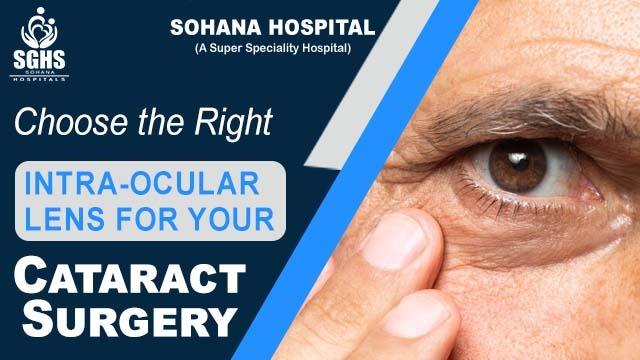Choose the Right Intra-Ocular lens for Your Cataract Surgery
April 12, 2024
Among ocular diseases, cataract is a major cause of blindness according to the Global Burden of Disease, Injuries, and Risk Factors Study (GBD), stating that it is the second leading cause of moderate and severe vision impairment. India conducted almost 83 lakh cataract surgery in 2022-2023.
Cataract surgery has evolved tremendously over the years, offering patients not just improved vision but also the opportunity to tailor their visual outcome to suit their lifestyle. One of the critical decisions in this journey is selecting the right intraocular lens (IOL). With different options available, it's crucial to understand the choices and how they can impact your vision.
Cataracts and the Need for Surgery
Before diving into IOLs, let's grasp the basics. A cataract occurs when the eye's lens becomes cloudy, leading to blurred vision and difficulty seeing clearly. Cataract surgery involves removing the cloudy lens and replacing it with an artificial one, restoring vision.
What Causes Cataracts?
A cataract is a hazy lens. The colored portion of your eye, known as the iris, is where the lens is located. The light that enters your eye is focused by the lens. This results in crisp, clear images on the retina, the back portion of the eye.
Your eyes' lenses are thicker, less clear, and less flexible as you get older. The breakdown and clumping together of proteins and fibers within the lenses can be attributed to aging and certain medical diseases. This is the reason why the lenses are cloudy.
The clouding gets worse when the cataract gets bigger. When light enters the lens through a cataract, it is both blocked and scattered. This keeps an image that is well-defined from getting to your retina. Your eyesight becomes blurry as a result.
Both eyes typically develop cataracts, though not always at the same pace. One eye's cataract may be worse than the other. This results in variations in vision between the eyes.
The Role of Intraocular Lenses (IOLs)
Now, let's talk about IOLs – the tiny yet mighty implants that determine your vision post-surgery. These lenses come in various types, each offering unique features and benefits.
Traditional Monofocal IOLs
Monofocal lenses provide excellent vision at one distance, typically for either near or distant vision. While they offer clear vision, patients may still need glasses for activities like reading or driving, depending on the chosen focus.
Multifocal IOLs
Unlike mono-focal lenses, multifocal IOLs offer vision at multiple distances, reducing the dependence on glasses for everyday tasks. They provide clearer vision for near and distant objects, enhancing overall visual quality.
Toric IOLs
Toric lenses are specifically designed to correct astigmatism, a common condition where the cornea or lens has an irregular shape. By addressing astigmatism, toric IOLs can significantly improve visual clarity without the need for additional corrective measures.
Accommodating IOLs
Accommodating lenses mimic the eye's natural focusing ability, allowing for a broader range of vision without sacrificing depth perception. These lenses adjust dynamically to different distances, offering greater flexibility and reducing the need for glasses.
Factors to Consider When Choosing an IOL
Selecting the right IOL involves considering various factors, including your lifestyle, visual preferences, and overall eye health.
Lifestyle and Hobbies
Think about your daily activities and hobbies. Do you enjoy reading, driving, or outdoor sports? Your chosen IOL should complement your lifestyle and provide optimal vision for the activities you love.
Visual Goals
Discuss your visual goals with your ophthalmologist. Whether you prioritize near--, intermediate, or distance vision, expressing your preferences will help tailor the choice of IOL to meet your needs.
Budget and Insurance Coverage
While cost shouldn't compromise your vision, it's essential to consider your budget and insurance coverage when selecting an IOL. Discuss financing options and potential out-of-pocket expenses with your healthcare provider.
Pre-existing Eye Conditions
If you have pre-existing eye conditions like astigmatism or presbyopia, choose an IOL that addresses these issues effectively. Your ophthalmologist will recommend the most suitable option based on your eye health.
The Role of Sohana Hospital in Your Journey
At Sohana Hospital, we understand the significance of clear vision in enhancing your quality of life. Our team of experienced ophthalmologists is dedicated to guiding you through every step of your cataract surgery journey, including selecting the perfect IOL for your needs.
Personalized Care
We believe in personalized care, and taking the time to understand your unique requirements and concerns. Our compassionate approach ensures that you feel supported and empowered throughout the decision-making process.
State-of-the-Art Technology
Sohana Hospital is equipped with state-of-the-art technology, allowing us to offer the latest advancements in cataract surgery and IOL options. From advanced diagnostics to precise surgical techniques, we prioritize your safety and satisfaction.
Comprehensive Follow-up Care
Your journey with Sohana Hospital doesn't end after eye surgery. We provide comprehensive follow-up care to monitor your recovery and address any post-operative concerns promptly. Your vision and well-being are our top priorities.
Embracing Clarity and Confidence
Choosing the right intraocular lens for your cataract surgery is a decision that can profoundly impact your vision and quality of life. By understanding the available options and considering factors like lifestyle, visual goals, and eye health, you can embark on this journey with confidence.
At Sohana Hospital, we're here to support you every step of the way, offering personalized care, cutting-edge technology, and unwavering commitment to your vision wellness by expert eye care specialists. Together, let's embrace clarity and embark on a journey towards a brighter, clearer future.
In the end, it's not just about restoring vision – it's about empowering you to see the world with newfound clarity and confidence.

